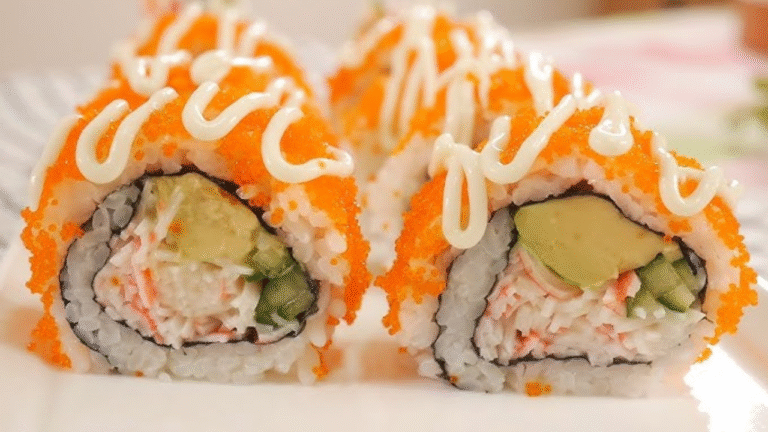Ever seen those bright orange fish eggs sprinkled on sushi and thought, “What is that?” Say hello to masago sushi — a sushi ingredient that might be tiny but packs a flavor punch.
Let’s explore what masago is, why it’s popular in Japanese cuisine, and how you can enjoy it in your next sushi bite.
What Is Masago?
The Basics: Capelin Roe
Masago sushi is the roe (eggs) of the capelin fish, a small forage fish found in cold ocean waters. The roe is small, crunchy, and naturally pale yellow, but it’s often dyed orange, red, or even green to make it pop visually on sushi.
Masago vs. Tobiko: What’s the Difference?
People often confuse Masago sushi with tobiko, which is flying fish roe. While they look similar, masago eggs are smaller, less crunchy, and generally more affordable than tobiko. If you’ve had sushi with tiny orange eggs and a soft crunch — that’s probably masago.
Why Masago Is Popular in Sushi
Flavor and Texture Combo
Masago adds a slightly salty, briny taste that balances out the richness of sushi rice and fish. The tiny “pop” when you bite into it gives sushi an extra layer of texture. It’s subtle, but memorable.
Versatility in Dishes
Masago isn’t just for nigiri. Chefs sprinkle it on rolls, mix it into sauces, and use it as an eye-catching garnish. It’s the culinary equivalent of confetti — tiny, colorful, and fun.
How Masago Is Used in Sushi
Masago Nigiri
One classic option is masago nigiri — a bite of sushi rice topped with a spoonful of masago, sometimes wrapped in seaweed. Simple, yet full of flavor.
Masago Rolls
Masago often finds its way into the outer layer of sushi rolls like California rolls or spicy tuna rolls. It adds that bold pop of color and a slight crunch with every bite.
Garnishing Other Sushi Creations
You’ll also see masago used to top sashimi plates, poke bowls, or even inside sushi burritos. It’s decorative and delicious.
What Does Masago Taste Like?
A Little Salty, a Little Sweet
Masago’s flavor is mildly salty with a slight oceanic sweetness. It doesn’t overpower the dish, which makes it a great companion to stronger ingredients like spicy tuna or wasabi.
That Signature Pop
Texture is key here. Masago gives that satisfying pop — not as intense as tobiko, but enough to keep things interesting on your tongue.
Is Masago Healthy?
Nutritional Breakdown
Masago is low in calories and high in protein, omega-3 fatty acids, and vitamin B12. A small spoonful offers solid nutrition in every bite.
Benefits and Concerns
While masago offers health perks, it’s often high in sodium. Also, it may contain added food coloring and preservatives, depending on how it’s processed. Like anything, moderation is key.
How Masago Is Harvested
Sustainability and Sourcing
Capelin are harvested in large numbers, especially in the North Atlantic. Responsible sourcing is crucial. Some sushi restaurants focus on sustainable seafood practices — it’s worth asking where your masago comes from.
Masago Beyond Sushi
Masago Mayo
Ever tried masago mayo? This spicy, creamy mixture is amazing on sushi, poke bowls, or even as a dip for fries. It’s often made by mixing mayo, sriracha, and masago for a flavor bomb.
Japanese Rice Bowls and Salads
Masago adds both flair and umami to Japanese rice bowls and cold salads. It’s like that surprise burst of flavor you didn’t know you needed.
Can You Make Masago Sushi at Home?
Tips for Beginners
Making masago sushi at home is doable — even fun! Start with sushi rice, some nori (seaweed), and a small container of masago. Try a simple masago-topped roll or a nigiri piece to get started.
Where to Buy Masago
Look for it in Asian grocery stores or order it online. It’s often sold frozen, so just thaw it in the fridge before using.
Is Masago Safe to Eat?
Allergy Notes
If you have a fish or shellfish allergy, steer clear. Masago is seafood and may be cross-contaminated during processing.
Raw vs. Pasteurized
Some masago is pasteurized, which helps preserve freshness and reduce risk. Always read the label or ask your sushi chef if you’re unsure.
Final Thoughts
Masago might seem like a small detail, but it brings major flavor, texture, and visual appeal to the table. Whether you’re trying it on nigiri, mixed into spicy mayo, or sprinkled over a roll, masago is one of those ingredients that turns good sushi into great sushi.
Next time you sit down at a sushi bar, give masago a shot. Your taste buds will thank you.
FAQs
1. Is masago raw or cooked?
Most masago served in sushi is raw but pasteurized. It’s safe to eat but should always be handled properly.
2. Can vegetarians eat masago?
No — masago is fish roe, so it’s not vegetarian or vegan.
3. What color is natural masago?
Naturally, it’s pale yellow. The orange, red, or green colors are usually added during processing.
4. Is masago spicy?
On its own, it’s not spicy. But it’s often mixed with spicy sauces like sriracha for a flavorful kick.
5. How long does masago last in the fridge?
Once opened, use it within 3–5 days. Keep it refrigerated and covered tightly to maintain freshness.

